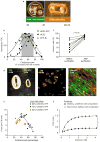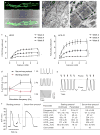Defined Engineered Human Myocardium With Advanced Maturation for Applications in Heart Failure Modeling and Repair
- PMID: 28167635
- PMCID: PMC5501412
- DOI: 10.1161/CIRCULATIONAHA.116.024145
Defined Engineered Human Myocardium With Advanced Maturation for Applications in Heart Failure Modeling and Repair
Abstract
Background: Advancing structural and functional maturation of stem cell-derived cardiomyocytes remains a key challenge for applications in disease modeling, drug screening, and heart repair. Here, we sought to advance cardiomyocyte maturation in engineered human myocardium (EHM) toward an adult phenotype under defined conditions.
Methods: We systematically investigated cell composition, matrix, and media conditions to generate EHM from embryonic and induced pluripotent stem cell-derived cardiomyocytes and fibroblasts with organotypic functionality under serum-free conditions. We used morphological, functional, and transcriptome analyses to benchmark maturation of EHM.
Results: EHM demonstrated important structural and functional properties of postnatal myocardium, including: (1) rod-shaped cardiomyocytes with M bands assembled as a functional syncytium; (2) systolic twitch forces at a similar level as observed in bona fide postnatal myocardium; (3) a positive force-frequency response; (4) inotropic responses to β-adrenergic stimulation mediated via canonical β1- and β2-adrenoceptor signaling pathways; and (5) evidence for advanced molecular maturation by transcriptome profiling. EHM responded to chronic catecholamine toxicity with contractile dysfunction, cardiomyocyte hypertrophy, cardiomyocyte death, and N-terminal pro B-type natriuretic peptide release; all are classical hallmarks of heart failure. In addition, we demonstrate the scalability of EHM according to anticipated clinical demands for cardiac repair.
Conclusions: We provide proof-of-concept for a universally applicable technology for the engineering of macroscale human myocardium for disease modeling and heart repair from embryonic and induced pluripotent stem cell-derived cardiomyocytes under defined, serum-free conditions.
Keywords: heart failure; models, cardiovascular; regeneration; stem cells; tissue engineering.
© 2017 American Heart Association, Inc.
Conflict of interest statement
A patent concerning serum-free EHM generation for applications in drug screens and heart repair has been filed by the University of Goettingen with M.T., J.H., and W.H.Z. listed as inventors. W.H.Z. is founder and scientific advisor of myriamed GmbH and Repairon GmbH.
Figures





Comment in
-
One Stride Forward: Maturation and Scalable Production of Engineered Human Myocardium.Circulation. 2017 May 9;135(19):1848-1850. doi: 10.1161/CIRCULATIONAHA.117.024751. Circulation. 2017. PMID: 28483831 Free PMC article. No abstract available.
References
-
- Thomson JA, Itskovitz-Eldor J, Shapiro SS, Waknitz MA, Swiergiel JJ, Marshall VS, Jones JM. Embryonic stem cell lines derived from human blastocysts. Science. 1998;282:1145–1147. - PubMed
-
- Takahashi K, Tanabe K, Ohnuki M, Narita M, Ichisaka T, Tomoda K, Yamanaka S. Induction of pluripotent stem cells from adult human fibroblasts by defined factors. Cell. 2007;131:861–872. - PubMed
-
- Yang L, Soonpaa MH, Adler ED, Roepke TK, Kattman SJ, Kennedy M, Henckaerts E, Bonham K, Abbott GW, Linden RM, Field LJ, Keller GM. Human cardiovascular progenitor cells develop from a KDR+ embryonic-stem-cell-derived population. Nature. 2008;453:524–528. - PubMed
MeSH terms
Grants and funding
LinkOut - more resources
Full Text Sources
Other Literature Sources
Medical

